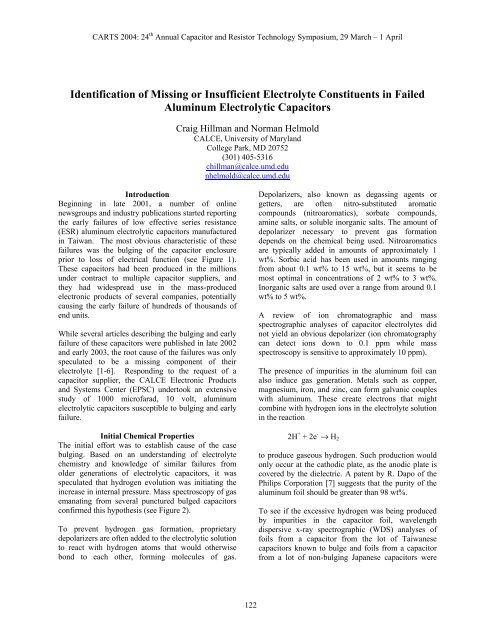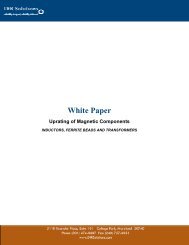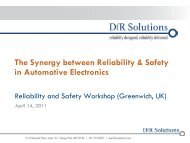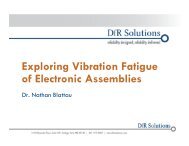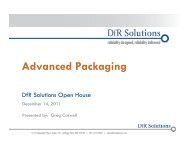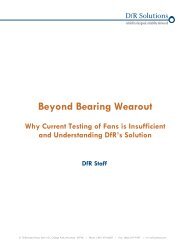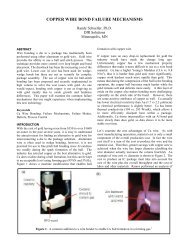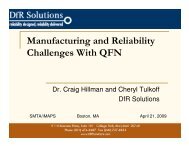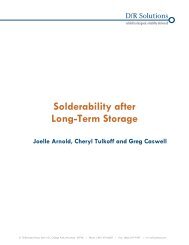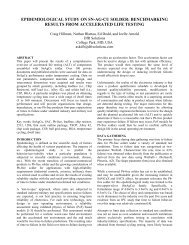Identification of Missing or Insufficient Electrolyte ... - DfR Solutions
Identification of Missing or Insufficient Electrolyte ... - DfR Solutions
Identification of Missing or Insufficient Electrolyte ... - DfR Solutions
Create successful ePaper yourself
Turn your PDF publications into a flip-book with our unique Google optimized e-Paper software.
CARTS 2004: 24 th Annual Capacit<strong>or</strong> and Resist<strong>or</strong> Technology Symposium, 29 March – 1 April<strong>Identification</strong> <strong>of</strong> <strong>Missing</strong> <strong>or</strong> <strong>Insufficient</strong> <strong>Electrolyte</strong> Constituents in FailedAluminum Electrolytic Capacit<strong>or</strong>sCraig Hillman and N<strong>or</strong>man HelmoldCALCE, University <strong>of</strong> MarylandCollege Park, MD 20752(301) 405-5316chillman@calce.umd.edunhelmold@calce.umd.eduIntroductionBeginning in late 2001, a number <strong>of</strong> onlinenewsgroups and industry publications started rep<strong>or</strong>tingthe early failures <strong>of</strong> low effective series resistance(ESR) aluminum electrolytic capacit<strong>or</strong>s manufacturedin Taiwan. The most obvious characteristic <strong>of</strong> thesefailures was the bulging <strong>of</strong> the capacit<strong>or</strong> enclosurepri<strong>or</strong> to loss <strong>of</strong> electrical function (see Figure 1).These capacit<strong>or</strong>s had been produced in the millionsunder contract to multiple capacit<strong>or</strong> suppliers, andthey had widespread use in the mass-producedelectronic products <strong>of</strong> several companies, potentiallycausing the early failure <strong>of</strong> hundreds <strong>of</strong> thousands <strong>of</strong>end units.While several articles describing the bulging and earlyfailure <strong>of</strong> these capacit<strong>or</strong>s were published in late 2002and early 2003, the root cause <strong>of</strong> the failures was onlyspeculated to be a missing component <strong>of</strong> theirelectrolyte [1-6]. Responding to the request <strong>of</strong> acapacit<strong>or</strong> supplier, the CALCE Electronic Productsand Systems Center (EPSC) undertook an extensivestudy <strong>of</strong> 1000 micr<strong>of</strong>arad, 10 volt, aluminumelectrolytic capacit<strong>or</strong>s susceptible to bulging and earlyfailure.Initial Chemical PropertiesThe initial eff<strong>or</strong>t was to establish cause <strong>of</strong> the casebulging. Based on an understanding <strong>of</strong> electrolytechemistry and knowledge <strong>of</strong> similar failures fromolder generations <strong>of</strong> electrolytic capacit<strong>or</strong>s, it wasspeculated that hydrogen evolution was initiating theincrease in internal pressure. Mass spectroscopy <strong>of</strong> gasemanating from several punctured bulged capacit<strong>or</strong>sconfirmed this hypothesis (see Figure 2).To prevent hydrogen gas f<strong>or</strong>mation, proprietarydepolarizers are <strong>of</strong>ten added to the electrolytic solutionto react with hydrogen atoms that would otherwisebond to each other, f<strong>or</strong>ming molecules <strong>of</strong> gas.Depolarizers, also known as degassing agents <strong>or</strong>getters, are <strong>of</strong>ten nitro-substituted aromaticcompounds (nitroaromatics), s<strong>or</strong>bate compounds,amine salts, <strong>or</strong> soluble in<strong>or</strong>ganic salts. The amount <strong>of</strong>depolarizer necessary to prevent gas f<strong>or</strong>mationdepends on the chemical being used. Nitroaromaticsare typically added in amounts <strong>of</strong> approximately 1wt%. S<strong>or</strong>bic acid has been used in amounts rangingfrom about 0.1 wt% to 15 wt%, but it seems to bemost optimal in concentrations <strong>of</strong> 2 wt% to 3 wt%.In<strong>or</strong>ganic salts are used over a range from around 0.1wt% to 5 wt%.A review <strong>of</strong> ion chromatographic and massspectrographic analyses <strong>of</strong> capacit<strong>or</strong> electrolytes didnot yield an obvious depolarizer (ion chromatographycan detect ions down to 0.1 ppm while massspectroscopy is sensitive to approximately 10 ppm).The presence <strong>of</strong> impurities in the aluminum foil canalso induce gas generation. Metals such as copper,magnesium, iron, and zinc, can f<strong>or</strong>m galvanic coupleswith aluminum. These create electrons that mightcombine with hydrogen ions in the electrolyte solutionin the reaction2H + + 2e - → H 2to produce gaseous hydrogen. Such production wouldonly occur at the cathodic plate, as the anodic plate iscovered by the dielectric. A patent by R. Dapo <strong>of</strong> thePhilips C<strong>or</strong>p<strong>or</strong>ation [7] suggests that the purity <strong>of</strong> thealuminum foil should be greater than 98 wt%.To see if the excessive hydrogen was being producedby impurities in the capacit<strong>or</strong> foil, wavelengthdispersive x-ray spectrographic (WDS) analyses <strong>of</strong>foils from a capacit<strong>or</strong> from the lot <strong>of</strong> Taiwanesecapacit<strong>or</strong>s known to bulge and foils from a capacit<strong>or</strong>from a lot <strong>of</strong> non-bulging Japanese capacit<strong>or</strong>s were122
perf<strong>or</strong>med. A small amount <strong>of</strong> magnesium wasdetected in both the Taiwanese and Japanese foils, andcopper was detected in the Taiwanese foils alone (seeTable 1). Ign<strong>or</strong>ing the topical constituents <strong>of</strong> oxygenand carbon, the purity <strong>of</strong> the cathodic aluminum foilfrom the Japanese capacit<strong>or</strong> w<strong>or</strong>ked out to beapproximately 99.1 wt%, which was within the limitset by Dapo. The purity <strong>of</strong> the cathodic aluminum foilfrom the Taiwanese capacit<strong>or</strong> was approximately97.5%, which was below the minimum value stated byDapo. The insufficient purity <strong>of</strong> the Taiwanesealuminum foil could cause gaseous hydrogenproduction that would not be impeded by adepolarizer, but the galvanic couples were not thoughtto be sufficient to account f<strong>or</strong> the rapid production <strong>of</strong>hydrogen gas that was necessary to cause therelatively rapid bulging <strong>of</strong> the capacit<strong>or</strong> cans.There were other anomalies in the ionchromatographic analyses, chiefly variations in theamounts <strong>of</strong> ammonium and phosphate ions present.Ammonium ions in water f<strong>or</strong>m ammonium hydroxide,which is strongly basic. This raised concerns about thepH <strong>of</strong> the electrolyte in the bulging capacit<strong>or</strong>s, as areview <strong>of</strong> the chemical properties <strong>of</strong> aluminum oxide –the dielectric – showed that it is slightly soluble inbasic solutions (but not in acidic)[8]. Measuring thepH <strong>of</strong> electrolytes from capacit<strong>or</strong>s from the Taiwaneselot known to bulge and from a Japanese lot that hadnot exhibited bulging showed that the electrolytes <strong>of</strong>the bulging lot were weakly basic (7 < pH < 8), whilethose <strong>of</strong> the non-bulging lot were acidic (pH 4).Initial Electrical InvestigationParametric measurements were perf<strong>or</strong>med oncapacit<strong>or</strong>s retrieved from the field. Review <strong>of</strong> resultsshowed that some <strong>of</strong> the capacit<strong>or</strong>s exhibited a risingcapacitance pri<strong>or</strong> to bulging. N<strong>or</strong>mally, due to loss <strong>of</strong>electrolyte through the base plug seal, electrolyticcapacit<strong>or</strong>s have a slightly decreasing capacitance untila rapid fall<strong>of</strong>f occurs at the end <strong>of</strong> life. It was possibleto explain the anomalous behavi<strong>or</strong> as the result <strong>of</strong>dielectric thinning, which could be due to dielectricdissolution in the basic electrolyte.Electrical TestingElectrolytic capacit<strong>or</strong>s from a lot known to besusceptible to bulging were subjected acceleratedstress testing at 55°C with a bias <strong>of</strong> 3.3 volts (theapplication voltage). Capacitance, ESR, and leakagecurrent were periodically measured at roomtemperature. The capacitance was found to increaseslowly up to 1100 micr<strong>of</strong>arads, at which point the rate<strong>of</strong> capacitance rise increased significantly and leakagecurrent exceeded manufacturer’s specifications. Thistrend continued until seal breakage and electrolyteloss, at which point capacitance and leakage currentplummeted and ESR increased (see Figures 4, 5, and6).This is in contrast to the behavi<strong>or</strong> seen with capacit<strong>or</strong>sfrom a different lot and capacit<strong>or</strong>s from a Japanesemanufacturer. Both capacit<strong>or</strong> sets displayed the m<strong>or</strong>ecommon degradation <strong>of</strong> a gradual decrease incapacitance.Chemical Testing<strong>Electrolyte</strong> samples from the suspect lot <strong>of</strong> Taiwanesecapacit<strong>or</strong>s, a different lot <strong>of</strong> Taiwanese capacit<strong>or</strong>s notexhibiting bulging, and a lot <strong>of</strong> capacit<strong>or</strong>s from twoJapanese manufacturers were subjected to additionalpH and ion chromatographic testing (see Table 2).Both Taiwanese samples were slightly basic, whileboth Japanese samples were acidic. Increased pH wasmost likely due to the presence <strong>of</strong> ammonium ions,which are present only in the electrolyte from theTaiwanese samples. The Taiwanese sample from thebulging lot did not contain significant amounts <strong>of</strong>phosphate ions, while that from the non-bulging lotdid. Similar results were seen with the electrolyte fromthe Japanese manufacturers, with phosphate ionspresent in one sample and absent from the other.Review <strong>of</strong> the chemical properties <strong>of</strong> aluminumphosphate showed that it is not soluble in basicsolutions [8], making it a candidate f<strong>or</strong> a protectivecoating on aluminum oxide in the presence <strong>of</strong> a basicelectrolyte.Suspecting that unprotected aluminum oxidedielectrics were dissolving into the alkalineelectrolytes, energy dispersive spectroscopy (EDS)was perf<strong>or</strong>med on evap<strong>or</strong>ated electrolyte from thecapacit<strong>or</strong> samples described previously. Theelectrolyte from the lot <strong>of</strong> Taiwanese capacit<strong>or</strong>sexhibiting bulging contained aluminum; aluminumwas not detected in the electrolyte from the othercapacit<strong>or</strong> samples (see Figure 6).DiscussionThe hypothesized root-cause <strong>of</strong> failure, insufficientbalance <strong>of</strong> pH and phosphate levels, has beenvalidated through the measurement <strong>of</strong> electrical123
ehavi<strong>or</strong> <strong>of</strong> capacit<strong>or</strong>s retrieved from the field.Capacit<strong>or</strong>s were found to have elevated levels <strong>of</strong>capacitance, which is an indication <strong>of</strong> thinning <strong>of</strong> thedielectric layer. Thinning <strong>of</strong> the dielectric layer is mostlikely due to dissolution <strong>of</strong> aluminum oxide into theelectrolyte. Dissolution in electrolytic capacit<strong>or</strong>soccurs when the concentration <strong>of</strong> phosphate isinsufficient in relation to the pH <strong>of</strong> the electrolytechemistry.It is imp<strong>or</strong>tant to note that the capacit<strong>or</strong>s underinvestigation had been tested by manufacturer to thespecified lifetime at maximum rated voltage atmaximum rated temperature. All electrical parameterswere found to be within specification at thecompletion <strong>of</strong> this industry standard test. The reasonf<strong>or</strong> this experience is that the high voltage required f<strong>or</strong>this test most likely sufficiently retarded dielectricdissolution until a time beyond the rated lifetime <strong>of</strong>these capacit<strong>or</strong>s.This experience points out a hazard <strong>of</strong> testing tospecifications, instead <strong>of</strong> testing to failure. Theindustry standard test is based upon an expectedfailure mechanism – electrolyte evap<strong>or</strong>ation. If anunexpected failure mechanism is introduced due tochanges in material <strong>or</strong> architecture, the assumedacceleration fact<strong>or</strong> may no longer be valid. A bestpractice approach is to test to failure, which isCALCE’s recommended testing regime f<strong>or</strong> electronicparts. If the manufacturer had tested to failure, it islikely that bulging would have been seennear the end <strong>of</strong> life, and this would have indicated theexistence <strong>of</strong> an unexpected failure mechanism.1. D. Zogbi, “Problems in Taiwan's AluminumCapacit<strong>or</strong> Industry,” Market Eye: Zogbi onPassives, October 14, 20022. C. Hillman, “Substandard Electronic Parts,”CALCE What’s New, October 2002,www.calce.umd.edu/whats_new/2002/China.pdf3. D. Zogbi, “Low-ESR Aluminum ElectrolyticFailures Linked to Taiwanese Raw MaterialProblems,” Passive Component Industry, Sept/Oct2002, p. 10, 12, 314. B. Liotta, “Taiwanese Cap Makers DenyResponsibility,” Passive Component Industry,Nov/Dec 2002, p. 6, 8-105. Y.T. Chiu and S.K. Mo<strong>or</strong>e, “Leaking Capacit<strong>or</strong>sMuck up Motherboards,” IEEE Spectrum Online,February 2003, www.spectrum.ieee.<strong>or</strong>g/WEBONLY/resource/feb03/ncap.html6. M. Langberg, “Scrimping Sometimes Doesn'tPay,” Mercury News Online, March 8, 2003,www.mercurynews.com/mld/mercurynews/business/5346302.htm7. R. Dapo, “<strong>Electrolyte</strong> containing a noveldepolarizer and an electrolytic capacit<strong>or</strong>containing said electrolyte,” U.S. Patent5,175,674, December 29, 1992.8. “Handbook <strong>of</strong> Chemistry and Physics,” 80 th ed.,D. Lide, Ed. Boca Raton, FL: CRC Press, 1999,pp. 4-37 and 4-38124
WDS X-RAY SPECTRA OF FOILSTaiwanese BulgingInner FoilOuter Foil(anode)(cathode)Atomic % Weight % Atomic % Weight %Aluminum 57.34 67.67 86.44 90.78Oxygen 33.25 23.27 8.41 5.23Carbon 5.52 2.90 3.65 1.71Calcium 1.00 1.75 0.46 0.72Phosp<strong>or</strong>ous 2.29 3.10 0.60 0.73Magnesium 0.23 0.25 0.17 0.16Copper 0.38 1.06 0.27 0.67BulgingJapanese Non-BulgingInner FoilOuter Foil(anode)(cathode)Atomic % Weight % Atomic % Weight %Aluminum 50.76 62.86 84.63 90.60Oxygen 39.32 28.88 9.94 6.31Carbon 7.63 4.21 4.74 2.26Calcium 1.99 3.65 0.08 0.09Phosp<strong>or</strong>ous 0.22 0.31 0.58 0.71Magnesium 0.08 0.09 0.04 0.04Copper ----- ----- ----- -----Table 1: Wavelength dispersive X-ray spectrographicanalyses <strong>of</strong> the foils <strong>of</strong> a Taiwanese bulging 1000micr<strong>of</strong>arad, 10 volt, aluminum electrolytic capacit<strong>or</strong>and the foils <strong>of</strong> a Japanese non-bulging 1000micr<strong>of</strong>arad, 10 volt, aluminum electrolytic capacit<strong>or</strong>.Rated Rated Origin Bulging pH NH 4 PO 4Capacitance Voltage Status1000 µF 10 V Taiwan Yes > 7 Yes No1000 µF 10 V Taiwan No > 7 Yes Yes1000 µF 10 V Japan No ~ 4 No Yes1000 µF 10 V Japan No ~ 4 No NoFigure 1: A bulged 1000 micr<strong>of</strong>arad, 10 volt,aluminum electrolytic capacit<strong>or</strong> manufactured inTaiwan in 2002. The photograph ahs been retouchedto obliterate manufacturer identity inf<strong>or</strong>mation.Table 2: Ion chromatographic and pH analyses <strong>of</strong>Taiwanese and Japanese capacit<strong>or</strong>s.125
302520151050BulgedTaiwanese Capacit<strong>or</strong>N + O -H 2+1234567H +891011121314151617181920m/ZFigure 2: Mass spectrograph <strong>of</strong> the gas from aTaiwanese 1000 micr<strong>of</strong>arad, 10 volt, aluminumelectrolytic capacit<strong>or</strong> that had just started to bulge.Current [µA]Leakage Current8000700060005000400030002000100000 4 8 12 16 20 24 28 32 36 40 44 48 52 56Time [days]Figure 4: Leakage current <strong>of</strong> capacit<strong>or</strong>s from thebulging Taiwanese lot tested at 55°C at a bias <strong>of</strong> 3.3volts. Diamonds indicate the earliest failure, which hascomplete data. Squares indicate the second group <strong>of</strong>failures; data collection f<strong>or</strong> these was terminated afterthey blew their cans <strong>of</strong>f. Triangles indicate the thirdgroup <strong>of</strong> failures, which had just started to bulge.Circles indicate a capacit<strong>or</strong> just starting to produce asignificant quantity <strong>of</strong> gaseous hydrogen.Equivalent Series ResistanceOH - H 2 O + 126Capacitance [µF]Capacitance240022002000180016001400120010000 4 8 12 16 20 24 28 32 36 40 44 48 52 56Time [days]Figure 3: Capacitances <strong>of</strong> capacit<strong>or</strong>s from the bulgingTaiwanese lot tested at 55°C at a bias <strong>of</strong> 3.3 volts.Diamonds indicate the earliest failure, which hascomplete data. Squares indicate the second group <strong>of</strong>failures; data collection f<strong>or</strong> these was terminated afterthey blew their cans <strong>of</strong>f. Triangles indicate the thirdgroup <strong>of</strong> failures, which had just started to bulge.Circles indicate a capacit<strong>or</strong> just starting to produce asignificant quantity <strong>of</strong> gaseous hydrogen.Resistance [m]20017515012510075502500 4 8 12 16 20 24 28 32 36 40 44 48 52 56Time [days]Figure 5: Equivalent series resistance <strong>of</strong> capacit<strong>or</strong>sfrom the bulging Taiwanese lot tested at 55°C at a bias<strong>of</strong> 3.3 volts. Diamonds indicate the earliest failure,which has complete data. Squares indicate the secondgroup <strong>of</strong> failures; data collection f<strong>or</strong> these wasterminated after they blew their cans <strong>of</strong>f. Trianglesindicate the third group <strong>of</strong> failures, which had juststarted to bulge. Circles indicate a capacit<strong>or</strong> juststarting to produce a significant quantity <strong>of</strong> gaseoushydrogen.
BulgingTaiwaneseDissolvedAluminumNon-BulgingTaiwaneseNo DissolvedAluminumFigure 6: Energy dispersive X-ray spectrographicanalyses <strong>of</strong> electrolyte samples from the Taiwanesecapacit<strong>or</strong>s exhibiting bulging and the Taiwanesecapacit<strong>or</strong>s not exhibiting bulging.127


